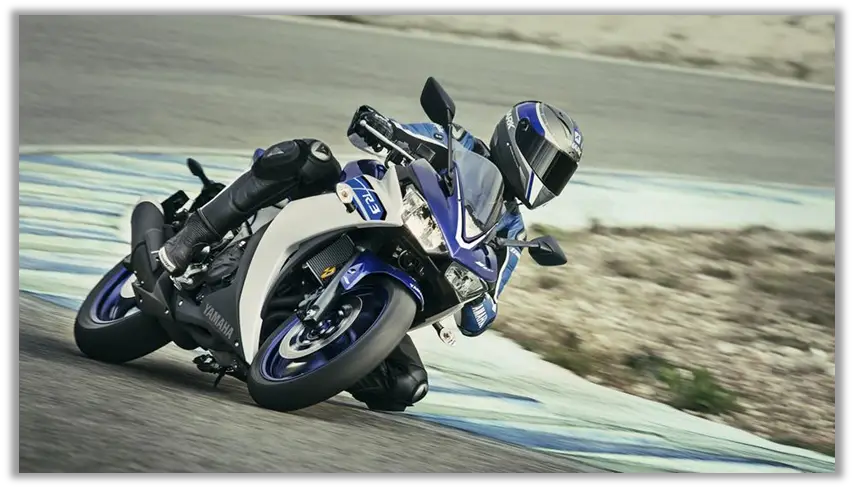Yamaha’s YZF-R3, or R3, is a 321 cc (19.6 cu in) inline-twin sport bike that has been on the market since 2015. The Yamaha R3 and R25 are the first twins that have an offset cylinder configuration. For 2019, the YZF-R3 has been upgraded. The engine in the Yamaha R3 produces 41.4 Bhp at 10750 rpm and 29.6 Nm at 9000 rpm. Since its debut in 2015, the R3 has proven to be a fantastic all-around machine. It’s so good; in fact, it’s Yamaha’s best-selling bike as of now. Since its release, 20,000 units have been sold.
Yamaha R3 bodywork and design are flawless, with meticulous attention to the smallest details. The Yamaha R3 is an entry-level sport motorbike that competes with Kawasaki Ninja 300, Honda CBR300R, and KTM 390 series motorcycles in the 250–400 cc categories. The engine, for example, is similar to that of the R25.
The 10-spoke cast-aluminum wheels reduce the sprung weight, and the engine features a downdraft induction fuel injection system. All of the cylinders are made of aluminum. The YZF-R3 now has ABS as an option for 2017. Dual-channel ABS is standard on the 2018 model, and it complies with Euro IV regulations. It has the characteristic sharp taillight design, as well as a boomerang-inspired side fairing and distinct front style. It boasts a stylish exhaust that is both short and nicely formed.
Yamaha R3 Features
The 321cc liquid-cooled inline 2-cylinder engine from Yamaha produces exceptional power and performance across the whole rpm range. The configuration minimizes vibrations for a smooth, refined engine character, thanks to a 180-degree crank design and incorporated counterbalance.
Whether riding through tight canyon curves or racetrack straightaways, a smooth-shifting six-speed gearbox ensures the rider always has the appropriate ratio.
Easy starting, good fuel economy, and responsive performance in all conditions are all provided by the downdraft induction fuel injection technology.
An antilock braking system enhances rider confidence and eliminates wheel lockups in reduced-traction circumstances, while a 298mm floating-mount front disc brake and a 220mm rear disc provide superb stopping power.
The single-shock design concentrates mass even more and is calibrated to create a balance between ride comfort and sporty performance, making it suitable for a wide range of applications, from urban commuting to track days. It also has a spring preload adjustment that compensates for people or cargo.
Pros & Cons
| Pros | Cons |
| Supersport styling | No pre-programmed ride modes |
| Comfortable to ride all-day | Non-adjustable front forks |
| Easy to control | 298mm front disc |
| Lightweight | Minimal suspension adjustment |
| Sizing is adaptable to a wide range of heights and weights | Soft brakes are ineffective |
Touring Performance
The R3 has clip-on handlebars that are attached to the forks, although they are slightly higher for a more relaxed seating position. As a result, you will be able to travel longer distances in more comfort.
From 100 to 0 km/h (62–0 mph), the 2015 R3 has a braking distance of 131.5 ft. Some reviews claim that the braking system isn’t powerful enough to match the engine’s output and that it’s prone to fishtailing when braking hard (non-ABS).
Keeping up with aggressive freeway speeds is not an issue, at least for lighter riders, because the most robust power can be found from 7000 rpm on up to the 10,500 red lines. While you can accelerate in top gear for a pass, downshifting will get the job done faster.
In metropolitan situations, you’ll feel the potholes and bumps of traffic-worn roads, but the YZF-R3 tackles them in stride. The suspension is firm enough for a sporting run on smooth asphalt in the canyons, and the quick handling allows you to flip into and out of curves. Cracked and wavy roads, on the other hand, will deter you from over-twisting the throttle, as the suspension is less reassuring under these conditions.
With a reported 56 mpg, the YZF-R3 is a frugal ride. While the 3.7-gallon tank can get you 200 miles between fill-ups, that economical mileage lowers while you’re driving through the canyons. Droning on the highway will also reduce your mpg to less than 50.

Tourist Reviews
“So, is the Yamaha R3 a good touring bike? Well, yeah, it’s not the best bike, but it’s a good one. The stock headlamps aren’t bright enough, and the thinly padded seat isn’t bum friendly because there aren’t any places for clamping bungee cords. Overall, I had a great time riding the Yamaha R3 on my ride, despite a few minor issues that were quickly rectified.”
By Arun Mohan Nadar
“The brakes are the R3’s most notable feature, and sadly, for the wrong reason; the two-piston sliding caliper up front lacks effective bite and feels grossly inadequate. It’s startlingly bad when you switch from the YZF-R125 to the R3. The lackluster brakes take away all of the confidence that the power delivery instils.”
By John Milbank
“Because my R3 appears powerful, comfortable, and trustworthy, there are a surprising number of excellent reasons to contemplate using it as a touring bike. In addition, my R3’s fuel economy (currently averaging about 64 miles per US gallon) is exceptional when compared to most touring bikes (35 to 45 mpg). “
By Jim Gnitecki
“Aside from its sporty aesthetics, the YZF-R3 is a comfortable and thrilling vehicle for any type of pavement job. I don’t think my smile ever left my face in 1,000 miles on this bike. Touring is undoubtedly an option and a pleasant one at that with its 3.7-gallon tank and astounding 26,600-mile valve adjustment interval.”
By Arden Kysely
Checkout our article on the Kawasaki Ninja 300 Ground Clearance Problems
The R3 is a credible, authentic, and practical sports bike that can entertain even the most dubious old goat of a motorcyclist. However, because the suspension is on the harsher side, this bike is best suited for occasional touring. Overall, it’s a fine bike, but it lacks the sparkle needed to entice potential consumers. It does the job, but it isn’t a true touring bike. R3 has a fabulous appearance. The speed is also frightening. When considering upkeep, we realize that it is pricey. However, it must be done regularly to avoid causing damage to the bike.





